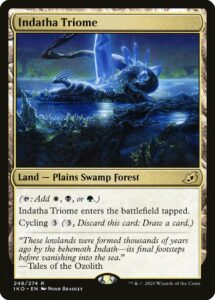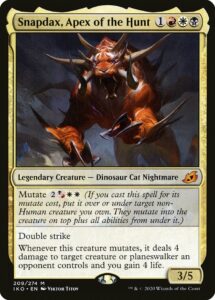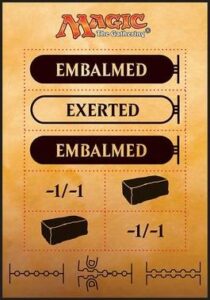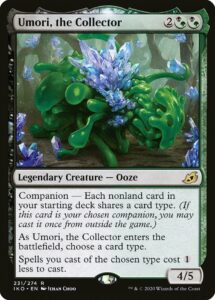As Magic nears its thirtieth birthday, it provides a mountain of design insight. Every set treads new ground, has triumphs and shortfalls, demonstrates lessons learned from the past, and creates new precedent for future sets. In this series, we’ll steadily delve through Magic’s massive array of mechanics. We’ve already hit on all five Standard sets of 2021, and while it’s too soon to provide a critical eye at Kamigawa: Neon Dynasty, we have plenty of perspective looking farther back. So today, we’ll look at one of the most consequential sets of 2021, Ikoria: Lair of Behemoths.
Wedge World, Again
Ikoria is Magic’s second take on a wedge world, where each color was paired with its two enemy colors. It was a very different take than Tarkir, Magic’s first iteration, which centered around Morph and ended up being defined by allied color dragons rather than enemy color strategies. Ikoria mixed these components together, so players got to have both their giant monsters and enemy colors.
Ikoria introduced three new mechanics: Mutate, Companion, and keyword counters. We’ll get to those in a moment, but it also featured a major innovation in one of Magic’s most revisited mechanics that’s worth mentioning. Let’s talk about Cycling.
When it was first introduced in Urza’s Saga, Cycling always cost 2 generic mana. When it returned in Onslaught block, Cycling costs become more varied, dropping down to a single colored mana on Tranquil Thicket or going as high as seven mana on Scourge’s Decree of Annihilation. Future Sight’s Street Wraith innovated the incredibly powerful and dangerous non-mana Cycling cost. Ikoria’s contribution was subtle but momentous—dropping the cost to a single generic mana. This had the cool, intended consequence of allowing for a powerful and memorable Cycling aggro/control Limited archetype that could play as few as twelve lands. It also badly warped the entire Limited format once players recognized that 1 mana cantrips which enable various synergies dwarfed almost everything else in power. Based on how that went, I wouldn’t be surprised if we never again see single generic mana Cycling used at volume.
Complicated and Cool Combinations
Mutate is a fascinating descendant of Bestow. Bestow presented an easy choice similar to Kicker’s—if you have the mana, you should almost always Bestow a Nimbus Naiad rather than cast it as a Wind Drake. The mechanic is all-upside, so the choice is straightforward.
Mutation requires more assessment of risk versus reward. Sure, you could Mutate to cheaply upgrade your creature, effectively give the Mutating creature Haste, and get a nice spell effect, but if it dies to Blood Curdle, you’re down two cards. Mutating a second time was an entirely different choice—since you’re unlikely to upgrade a creature’s stats significantly by adding a third creature to the stack, you’re now assessing whether it’s worth cashing in your creature for two spell effects. The end result was exciting, risky gameplay with a bunch of play to it (that also unfortunately got outgunned by Cycling in Limited and wasn’t strong enough for Standard).
Mutate is a very complex mechanic. It combines creature’s text boxes, has a secret throw case where killing a target while a Mutating creature is on the stack gives you your original creature, does not work on humans, and has all sorts of funky rules interactions. Its announcement was part of Wizards’ intentional increasing of Magic’s mechanical complexity, a trend that has persisted through Kamigawa: Neon Dynasty. As the first set of pandemic Magic, we never really got to see how players interacted with Mutate en masse without a digital engine taking care of all the busywork behind the scenes, making it hard to judge whether Mutate crossed the line or not.
With almost two years of hindsight, Mutate strikes me as a bit disappointing as a marquee mechanic. Much of that isn’t the mechanic’s fault (it was outshone by Cycling and Companion’s aforementioned power level issues, and Play Design was clearly cautious about the mechanic), but some of it is. Variance is a source of fun, but a mechanic that is entirely about properly assessing risk, where oftentimes the right choice is to ignore most of a card’s text and play it as a French vanilla creature, makes the mechanic less memorable and appealing. Moreover, it may be challenging to bring back given that it demands almost every Mutate creature have a “when this creature Mutates” trigger that’s worth a reasonable bonus and can’t easily form an infinite loop. So while Mutate is cool, the combination of rules issues, possibly limited design space, and its low power level, I’m not sanguine about its returning soon.
Super Punch-Out Counters!!
Magic has long had a firm rule about counters: there can only be one. More specifically, each set should only have one type that’s commonly put on creatures. The game just get confusing when a creature has both a +1/+1 counter and a charge counter on it, especially while another creature has a +1/+1 counter and an agecounter (and +1/+1 and -1/-1 counters shall never coexist in Limited… outside of a Masters or Horizons format). Ikoria is the set that broke this rule, and broke it hard.
Ikoria had ten creature counters. It even went so far as to have creatures like Duskfang Mentor that intentionally distributed two different types of counters. To make this possible, Ikoria employed Amonkhet’s punch out technology so players would have clear and official counters to clarify the state of the battlefield. This meant that a card like Crystalline Giant, which previously could only exist as an Un-card, could work by simply shuffling a handful of cardboard counters rather than figure out how to turn a d20 into a d9.
Ability counters are more versatile than designs like Benalish Lancer and Sinuous Vermin, where a +1/+1 counter signifies two abilities. It unlocks brand new affordances, like how Blood Curdle provides permanent Menace (Magic is a hungry monster, and having more boons like Blood tokens that are worth less than one mana is a huge boon). We’ve just seen them return in Kamigawa: Neon Dynasty, which did not include physical keyword counters (due to only three cards using keyword counters). There’s a lot to appreciate about them, so it’s not surprising that keyword counters quickly became deciduous.
The biggest concern I have about keyword counters is that because of the pandemic, we never really got to see whether they achieved their goal of clarifying garbled boardstates. Sure, they play fairly cleanly in digital, where the Arena or Magic Online engine ensures that you always have the right counters on hand. But I’ve now had a taste of life without keyword counters by combining Kumano Faces Kakkazan with Kappa Tech-Wrecker. It wasn’t hard to parse that board state (thanks to howrestrained Wizards was in their use of keyword counters), but it was a tad awkward having two dice on the same creature communicating different things. I wonder if they’d have been as quickly embraced if more people had played with Crystalline Giant as originally intended. So, while I’m excited to see how they’re employed next, the fact that Wizards used them on only three cards in Neon Dynasty and without actual keyword counters makes me suspicious that they either need to be used at high densities (justifying punch out cards) or extremely low densities.
The Elemental Elephant Dinosaur in the room
Companion is, without a doubt, one of the most powerful and befuddling mechanics Magic has ever made. It has the dubious distinction of being the only mechanic to be wholesale revised, and done so almost immediately after its release. The one saving grace of this issue being that the mechanic is so complicated, it was never actually written out on a card in full. Companion remains a staple of every competitive Constructed format by virtue of how small a cost it is to give up a sideboard slot in exchange for an eighth starting card. But, if you’re at all familiar with Companion, you’re likely well aware of these issues. So rather than repeat what you already know about this controversial-at-best mechanic, let’s focus on what you might not.
Companion was awesome in Limited. Sure, not all Companions were created equal, but it was exciting to have an actual factual quest during the draft. It felt great to have a one-use Commander that synergized with your entire deck’s construction. It completely reshaped card evaluations, allowing for extremely dynamic draft pick orders and extremely varied applications of cards. Sure, the downside was stark—it could be frustrating playing against your opponents with a well-built Lurrus of the Dream-Den or Jegantha, the Wellspring—but each Companion was an entire Limited archetype unto its own. Without Companions, the format only had three archetypes: RWu Cycling, BGU Mutate, and WB Humans (with all the allied color pairs being mostly synergy-free traps). Companion made the Limited format work and added longevity and excitement to a format that otherwise would have been woefully short on options.
Companions may well have been a laudable attempt to get Standard and Commander players to engage with each other. 2020 was The Year of Commander and Ikoria was following on the heels of 2019’s introduction of Brawl. It made good sense for Wizards to continue trying to entice Commander players into modes of play without the scourge of all nonrotating formats: power creep. Companion also gave Standard players a taste of what it was like to always have access to your deck’s central creature. Perhaps it even put Standard players in dialogue with Commander players who they otherwise would never have played with. I’m not sure if this was in fact a goal, and if so, I’m not sure if it succeeded at all, but I applaud the effort. So, while Companion deserves its place in history as one of Magic’s most problematic and shocking mechanics, it’s certainly not unworthy of praise as well.
And with that, we close the chapter on Ikoria: Lair of Behemoths. Reflecting on it, I have little fondness for all of its new mechanics. Mutate had too little power, too much complexity, and too much risk. Keyword counters were fine, but to me feel more like a useful tool than something to be excited about. Companion I actually had a lot of fun with, but that doesn’t outweigh the damage it did to every Constructed format. And all of it lay beneath the long shadow of Cycling, which managed to be utterly overpowered while also barely only slightly innovated upon, hardly a winning a combination. I would’ve thought I’d have had more fondness for the set because of how well I did with on Magic Arena and how fun the Cycling deck was in the first few days, but between the mechanical design and the immense pall of Spring 2020, I have no nostalgia for Ikoria. It’s a bleak end, but that’s perhaps a fitting feeling for all the Gyruda, Doom of Depths fans.
Zachary Barash is a New York City-based game designer and the commissioner of Team Draft League. He designs for Kingdom Death: Monster, has a Game Design MFA from the NYU Game Center, and does freelance game design. When the stars align, he streams Magic (but the stars align way less often than he’d like).





